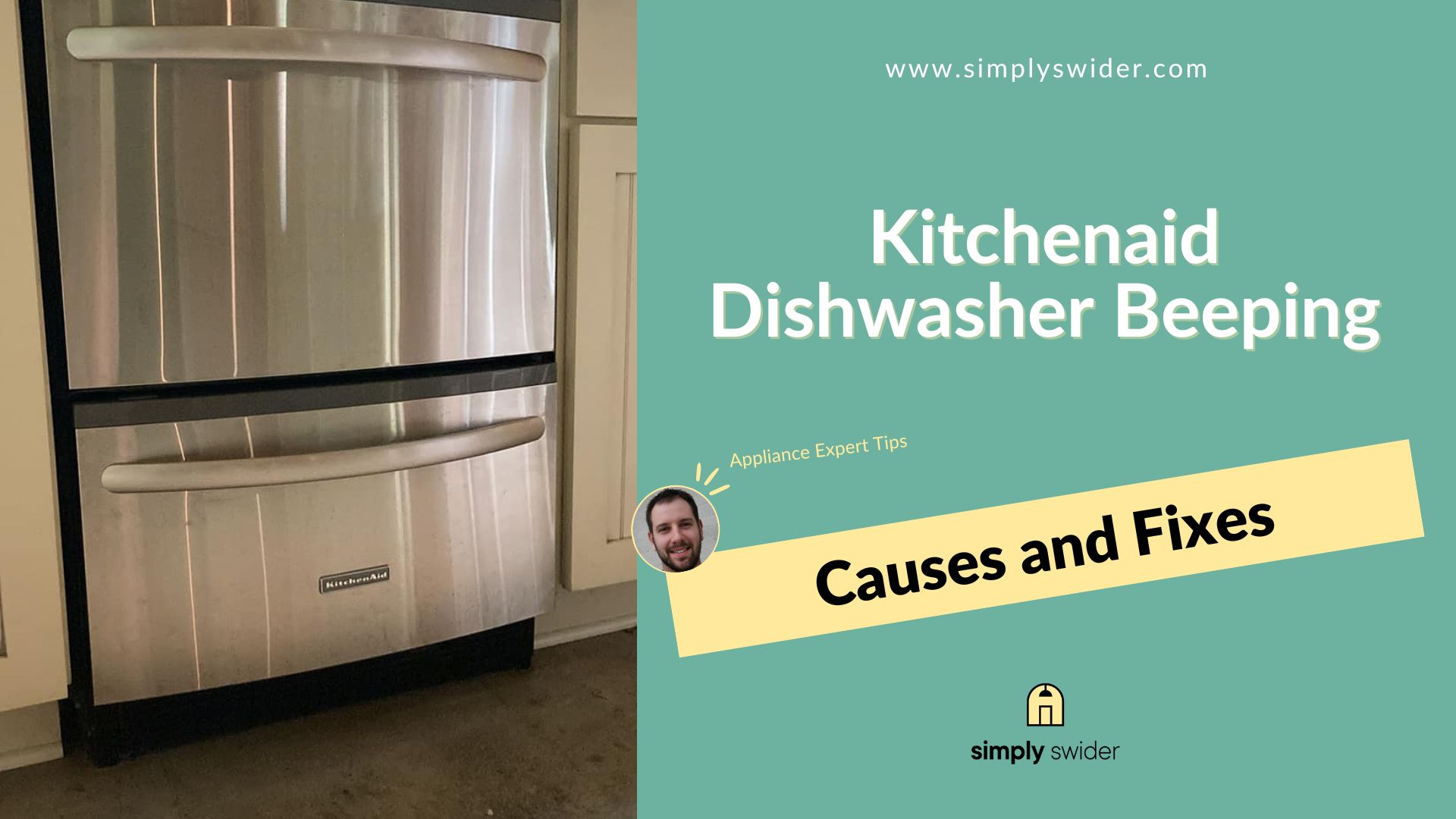When you’re navigating the world of KitchenAid dishwashers, as I have for years, you quickly learn that certain sounds just come with the territory.
That end-of-cycle beep or the pause-notification chime? All part of the experience.
But:
What happens when your reliable dishwasher decides to go rogue, beeping unexpectedly as you initiate a cycle, or perhaps even during and after the cleaning process?
Before you panic, I have some good news:
In this post, I’ve teamed up with Finn Reid, a seasoned repair technician from the heart of Texas. Having crossed paths with this issue more times than we can count, Finn and I decided to bring our collective wisdom to the table and tackle this persistent problem together.
So, buckle up, and let’s navigate this beeping conundrum together!
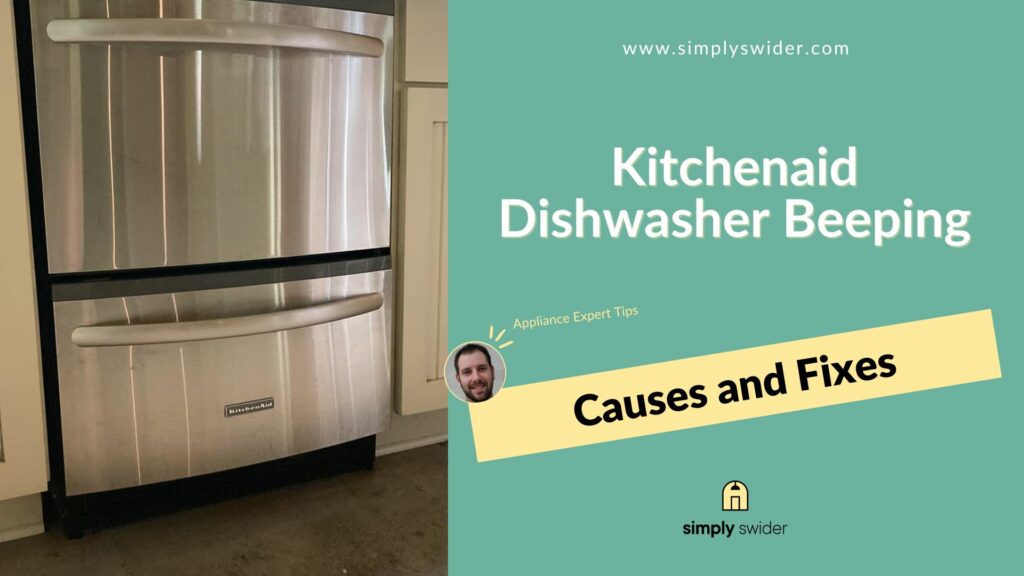
Table of Contents
Kitchenaid Dishwasher Beeping? 9 Likely Culprits
1. Door Opening Mid-Cycle (Cycle Interrupt Mode)
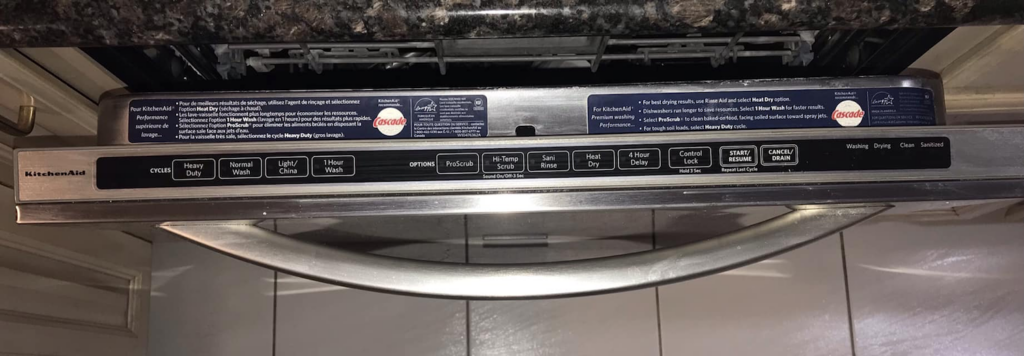
Problem:
Finn agrees with me that opening and closing the dishwasher door midcycle is one of the most common reasons why KitchenAid dishwashers will all of a sudden start beeping.
As Finn explains,
“This is common when users want to retrieve or add something during a cleaning cycle.”
Identification and Solution:
If you were not the one operating it, simply inquire with other household members to know if someone opened the dishwasher door mid-cycle.
To exit the cycle interrupt mode and resolve the beeping issue, all you need to do is open the door and then press the Start/Resume button.
You know what?
Interrupting a KitchenAid dishwasher mid-cycle might not be the best move after all.
Finn and I have come across KitchenAid dishwashers that developed serious problems after the door was opened mid-cycle.
For instance:
Finn tells me of a situation where he had to replace the control panel on a Kitchenaid KUDS30FXSS9 dishwasher after a cycle was interrupted.
Recently:
Another user in our Simply Swider Facebook Group had to replace the pricey control board on their KUDE70FXSS5 model.
There is also this Redditor whose dishwasher developed consistent problems when she opened the dishwasher mid-cycle to grab something.
That’s not all:
Opening the dishwasher mid-cycle can have other sneaky impacts, such as the accumulation of water in the drip tray.
2. Water In The Drip Tray or Leak Pan
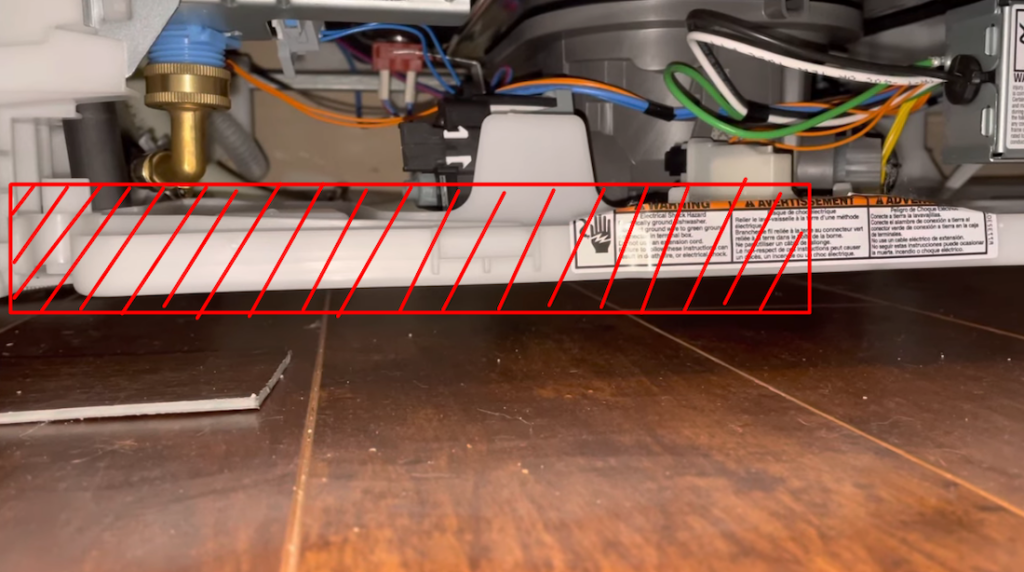
Problem:
Another potential culprit for the mysterious KitchenAid dishwasher beeping issue is when there is water in the drip tray (leak pan).
Finn tells me that this was the culprit behind the last KitchenAid dishwasher he attended with this problem.
Now:
As Finn explains, “When water finds its way into the drip tray/leak pan, whether from a leak or a spill, it sets off the dishwasher’s flood sensor.”
How?
The drip tray sits strategically at the bottom of the machine to capture any leaks, while the float assembly hovers above it.
When the float assembly detects water in the pan, it prompts the leak detection mechanism to shut off the unit.
To let you know about the accumulation, the dishwasher may start beeping.
Now:
The major causes of water accumulation in the drip tray include,
- Opening the door mid-cycle.
When you open and close the dishwasher’s door during a cycle, air pressure surges can force water droplets down into the leak pan
- Leak
Water leaking from parts such as the water inlet valve, a faulty diverter motor seal, a damaged door seal, or even a leaking drain pump ends up in the drip pan.
- Spills or splashes from the countertop can find their way into the drip tray.
- When the dishwasher isn’t sitting level.
- Excessive suds can find their way to the leak pan.
Identification:
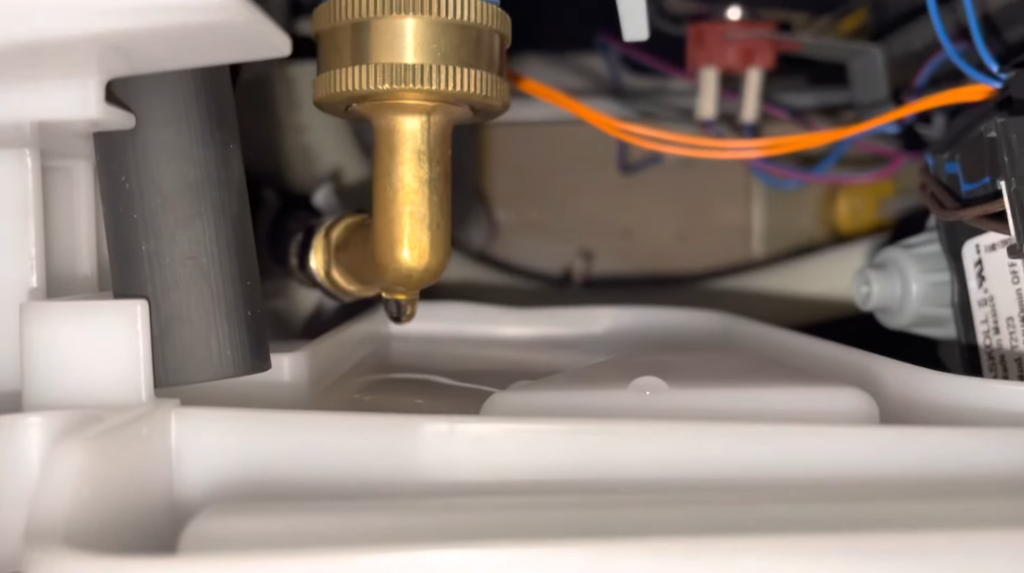
The first telltale sign of water in the drip pan is when the dishwasher displays the F8E4 error code.
However, sometimes the dishwasher may not show any errors at all.
According to Finn, “You should locate and inspect the drip pan even if there’s no related error code showing up.”
Solution:
Simply remove the bottom panels and locate the drip pan. If there is water, remove it and dry it.
Next, inspect the overfill switch, especially the connections, and also test for resistance to make sure it is not shorted from the overfill.
Finally, install the pan, connect the float switch, and confirm that the styrofoam float can move freely.
Example:
This user’s KitchenAid dishwasher model #KDTM404KPS0 was beeping 3 times. Upon investigation, he found there was water in the leak pan.
This issue was resolved by drying the pan and resetting the dishwasher.
Note:
Ensure that you have identified the source of the leak.
Grab a flashlight and shine a light on the area down there. See if you can spot where the leak is coming from.
3. Using The Wrong Detergent
Problem:
Here’s the deal:
Hand soap, dish detergent, and other types of soap are a strict no-go for your dishwasher.
Trust me, using any of these in your dishwasher is almost a surefire way to stir up trouble, and yes, that includes those annoying beeps.
For instance, this user on Facebook accidentally used dish soap instead of dishwasher detergent in their KitchenAid KDTM404KPS0 Dishwasher.
The result?
An overflow of suds, and, as you’d expect, the dishwasher started beeping.
Note:
Excessive suds can also be caused by:
- Using too much detergent.
- Rinse Aid leaks, for instance, if the compartment is open.
Identification:
As Finn explains,
“The first sign of excessive suds is usually visible foam. If there are too many suds, they can start leaking from the dishwasher.”
Question:
Have you noticed that your dishes or glassware have been feeling slippery or soapy? Well, that’s another sign that you could be using too much detergent.
Lastly:
The dishwasher may display a sud error such as F6E3.
Solution:
In an unfortunate mishap, this user accidentally used dishwashing detergent in their KitchenAid Dishwasher KDTM404KPS0, and it immediately started beeping.
Upon investigation, he found that water had accumulated in the drip pan, triggering the beeps. The issue was fixed by drying the drip pan.
This other user on Facebook experienced the same problem with his Kitchenaid KDTM354DSS4 dishwasher after accidentally loading soapy dishes
So:
If you are dealing with excessive suds, the first thing to do is switch off the dishwasher. Then;
- Wipe off any overflowing suds
- Remove dishes from the dishwasher
- Use a cup to scoop suds from the dishwasher
- Add 3 tbsp. of cooking oil to the bottom of the dishwasher.
- Run a cycle when the dishwasher is empty
If the dishwasher is stuck and not responding, unplug it and let it sit for a few minutes before plugging it back in.
Next:
Locate the drip tray and check if there is any water. If there is, drain the water out and also test the float switch assembly for continuity.
4. Error Detected
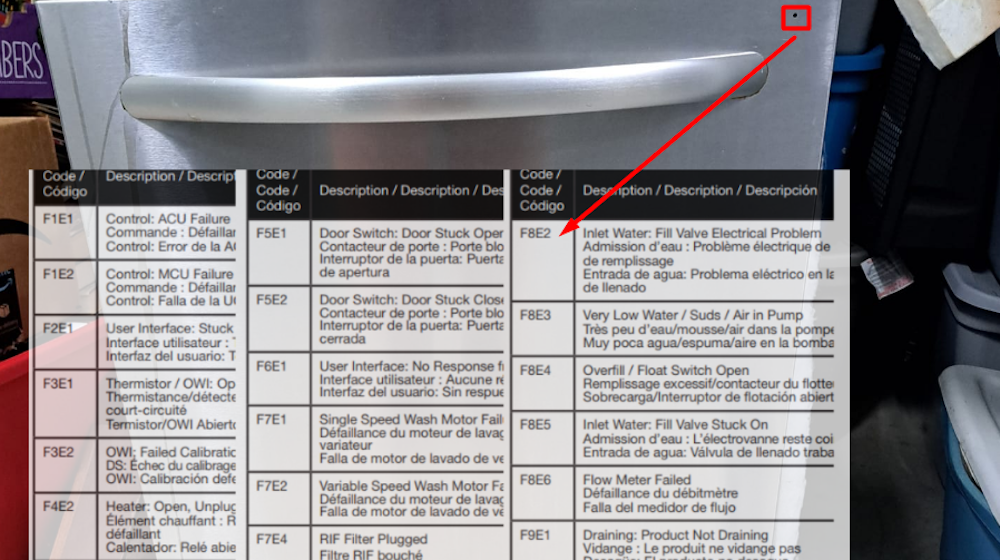
Problem:
Here is the thing:
Most of the time, the beeping is accompanied by an error code. The beeping is to grab your attention, while the error code tells you exactly what’s going on.
That’s why if you call KitchenAid support, the first thing they will ask you is if the machine is displaying an error code.
However, these error codes can be a bit tricky to retrieve and interpret.
Now:
Besides knowing how to retrieve the error codes, you will also need the tech sheet that explains the meaning and recommended action for the error codes.
Surprisingly, very few owners know where to find it.
According to Finn, “The tech sheet is usually located in a plastic pouch, mostly behind the kick plate at the bottom of the dishwasher.”
The next step is to put the dishwasher in diagnostic mode.
How to run a diagnostic test on a KitchenAid dishwasher
- Step 1: Make sure the dishwasher is connected to the power source.
- Step 2: Now choose and press any 3 keys (except Start, Cancel, or Delay buttons) in the format 1-2-3, three times. That is (1,2,3) (1,2,3) (1,2,3)
For instance, the {Extended Heat Dry} + {High-Temp Wash} + {Sani Rinse} buttons, as this user does.
If you do it correctly, all the lights on the display will come on. Then close the door.
- Step 3: Pay attention to the front light.
The light on the front will blink in two phases. Count the number of times the light blinks before and after the pause.
For instance:
If the light blinks 3 times, then pauses and blinks another 5 times. The error code is 3-5.
- Step 4: Refer to the tech sheet for the meaning of the error code and what to do.
Once you’ve retrieved the error code, go ahead and test if the issue has been resolved.
According to Finn, “You might be in for a pleasant surprise because, in some models, this technique resets the dishwasher, effectively fixing software-related problems.”
Identification and Solution:
Below are some of the most common Kitchenaid dishwasher error codes and their meanings.
| Error Code | Meaning |
|---|---|
| F1E1 | Control board problem |
| F1E2 | Memory problem on control board |
| F2E1 | Stuck Key on the user Interface: |
| F3E1 | Thermistor or Turbidity Sensor problem |
| F3E2 | Turbidity Sensor Failed Calibration |
| F4E2 | Heater or Failed Relay |
| F4E3 | Heater: Relay Shorted or Heater Failed |
| F5E1 | Door Switch- Door Stuck Open |
| F5E2 | Door Switch- Door Stuck Closed |
| F6E1 | User Interface- No Response from ACU |
| F7E1 | Single Speed Wash Motor Failure |
| F7E2 | Variable Speed Wash Motor Failure |
| F7E4 | RIF Filter Plugged |
| F8E1 | Inlet Water- No Water / Tap Closed |
| F8E2 | Inlet Water- Fill Valve Electrical Problem |
| F8E3 | Very Low Water Suds Air in Pump |
| F8E4 | OverfillFloat Switch Open |
| F8E5 | Inlet Water- Fill Valve Stuck On |
| F8E6 | Flow Meter Failed |
| F9E1 | Draining: Not Draining |
| F9E2 | Drain Motor Electrical Problem |
| F9E4 | Tub Light Failure |
| F10E1 FAE1 | Dispenser Electrical Problem |
| F10E2 | Vent Wax Motor Electrical Problem |
| F10E3 FAE3 | Drying Fan Electrical Problem |
| F10E4 FAE4 | Diverter Cannot Find Positions |
| 6-4 | Float switch |
Finally:
As Finn explains, “The way to get into diagnostic mode might be different depending on your specific model. So make sure to get the specific tech sheet for your model.”
To add to his point:
Some KitchenAid dishwashers might have additional or different error codes.
5. Software Glitch

Problem:
Another common cause of beeping in KitchenAid dishwashers is a software glitch, software bug, or memory issue.
For instance:
A software glitch could potentially cause the dishwasher’s control board to get stuck in a loop or fail to process the essential commands.
This is very common after a power outage.
For instance, according to this user in our Facebook Group, “After a power outage, our KDTM404K KitchenAid dishwasher won’t stop beeping, even though the power is now restored.”
Identification and Solution
The most straightforward technique to rule out or fix a software glitch is to reset the dishwasher.
How?
Simply unplug the dishwasher from the outlet and wait a few minutes before plugging it back in. If the unit is hardwired, flip the circuit breaker off instead.
According to Finn, “A power reset can fix some software glitches and other control board issues.”
Another technique to reset your KitchenAid dishwasher is to use the Energy Saver Dry’ and ‘Hi-Temp Scrub’ buttons.
Simply press the two buttons alternating 5 times. If you do it well, the control panel lights will flash for a few seconds.
Then let the unit sit for at least 10 minutes and initiate a new cycle.
6. Faulty Door Latch Switch Assembly
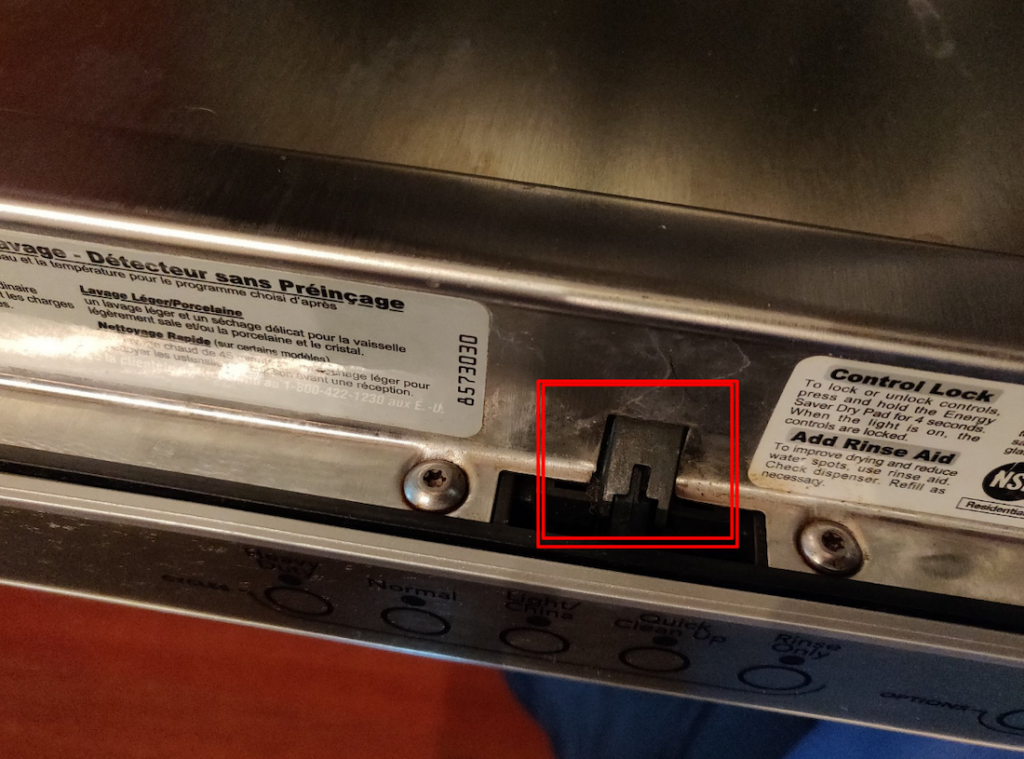
| Part | Door Latch Switch Assembly |
| Location | Along the top edge of the dishwasher’s door. |
| Ease of troubleshooting | Medium |
| Repairable | No, unless the issue is damaged wires |
| Cost of replacement | $20-$100 |
Problem:
As Finn points out, “For safety reasons, dishwashers are designed not to start unless the door is securely locked.”
That’s where the door latch assembly comes in.
The latch secures the door, while the switch communicates to the control board about the door’s status—open or closed.
Now:
If the latch is defective or not properly engaged, your dishwasher might start beeping to signal an error.
Identification:
The first indication that the door latch might be the issue is if there is a door-related error code (F5E1) and if the beeping is only happening when you shut the door.
Next:
Close the door and assess how it feels and if you can hear the locking sound.
Finally, locate the door latch and inspect it for signs of wear, damage, or misalignment. Pay close attention to the connections and the switch.
Solution:
If you encounter issues with the latch assembly, replace it.
7. Malfunctioning or Faulty Control Board
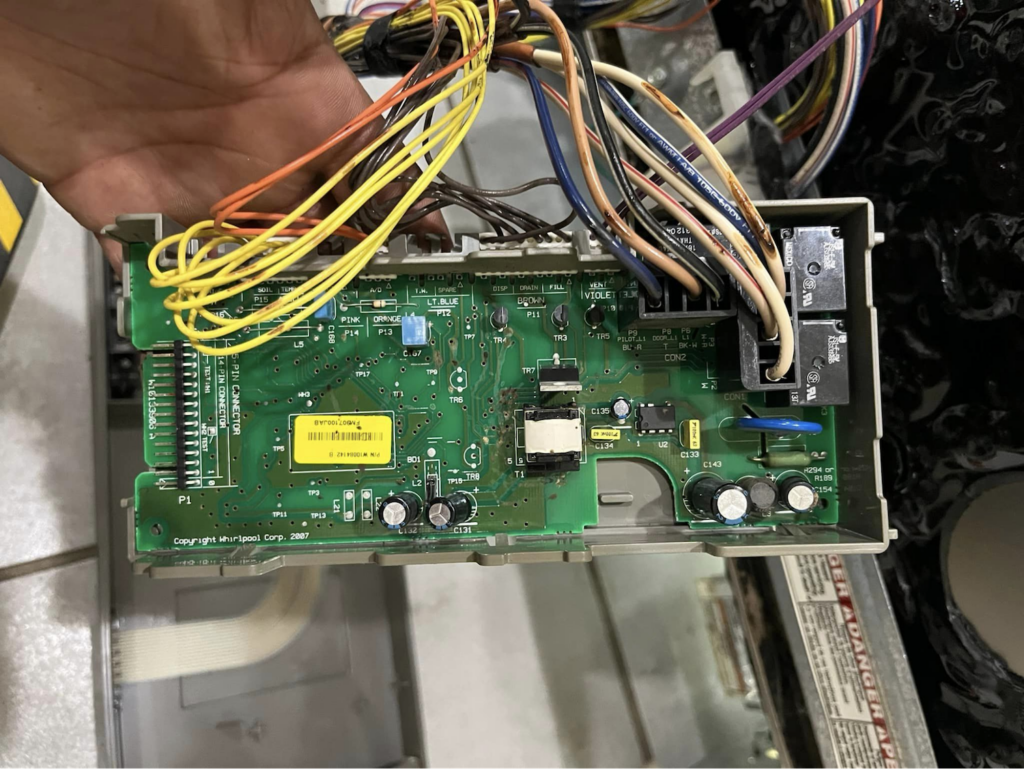
Part | Control board |
| Location | Behind the front control panel |
| Ease of troubleshooting | Very hard |
| Repairable | Yes |
| Cost of replacement | Most KitchenAid models have a 5-year control board warranty. $200-$500 |
Problem:
Another potential cause for your KitchenAid dishwasher’s unexpected beeping could be a faulty or malfunctioning control board
As Finn explains:
“The control board is one of the most vital and heavily utilized components as it controls and coordinates all the different functions and components.”
If the control board is faulty, it can lead to erratic behavior such as beeping even when the unit is not being used.
Identification:
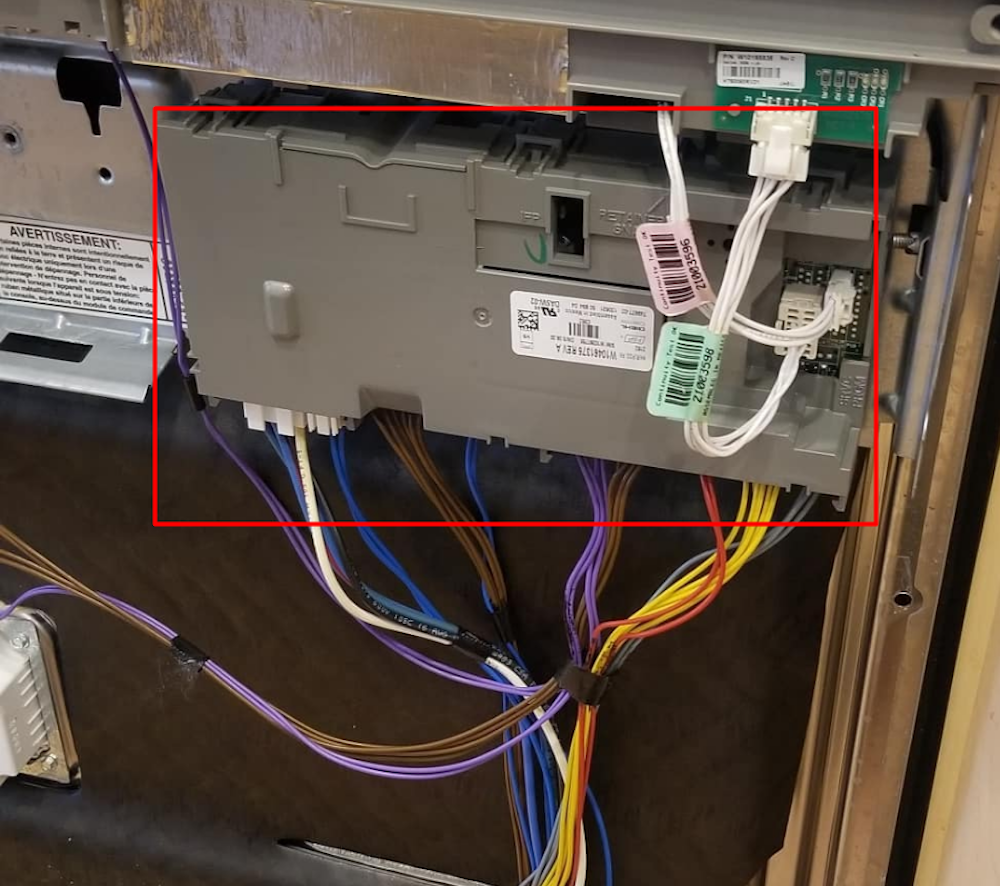
“The control board is composed of tens of small components such as capacitors, memory chips, and power supply circuitry, among others,” Finn explains.
Unfortunately:
This complexity makes it one of the most challenging components to diagnose and repair.
Here are a few steps you can take:
Begin by resetting the board, which can often rectify errors and software glitch-related issues.”
Secondly, run the dishwasher in diagnostic mode and look out for control board-related error codes, specifically F1E1 or F1E2.
Thirdly:
Locate the control board and inspect it for burn marks, corroded terminals, damaged components, and loose connections.

Solution:
If you’ve determined that the control board is indeed the problem, it’s time to replace it.
Fortunately, most KitchenAid dishwasher models come with a 5-year warranty on the control board. So, check your owner’s manual to confirm your warranty details.
If yours is covered, reach out to KitchenAid at 800-422-1230 and make sure to provide proof that the control board is damaged.
8. A Faulty Wash Motor
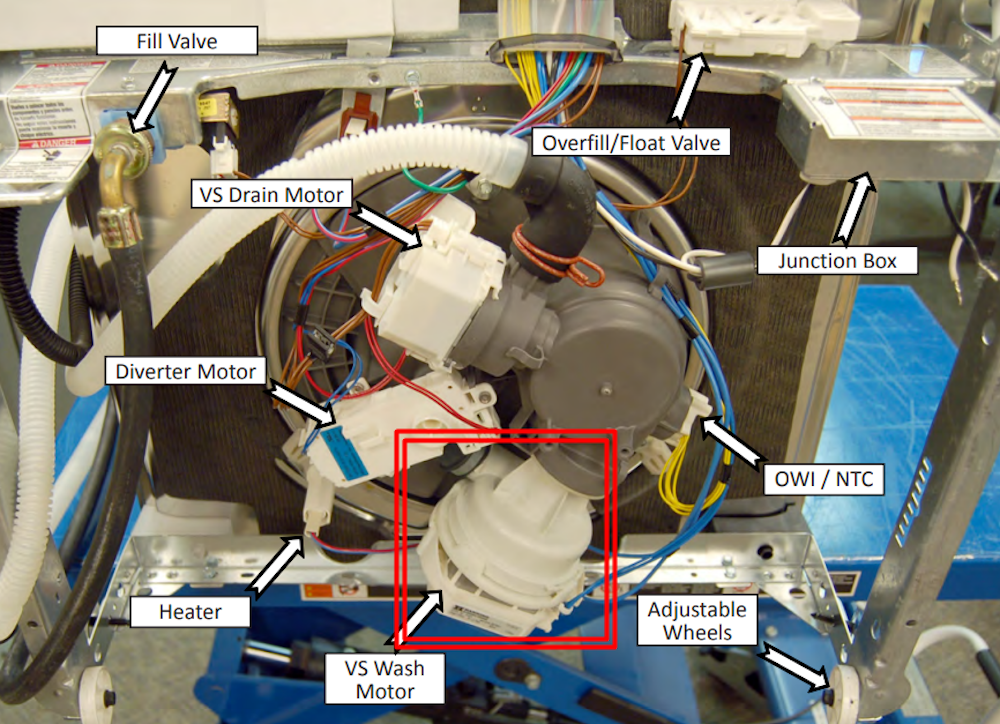
| Part | Wash motor (circulation pump) |
| Location | At the bottom |
| Ease of troubleshooting | Very hard |
| Repairable | Yes |
| Cost of replacement | $200-$350 1 year warranty on some models |
Problem:
If your dishwasher fills with water and then starts beeping, the potential culprit could be the wash motor.
As Finn points out,
“Once the dishwasher fills with water, the wash motor takes over. It pumps water up into the spray arms, which then rotate and spray your dishes,” Finn expounds.
If this is not happening, the dishwasher may start beeping to alert you.
Identification:
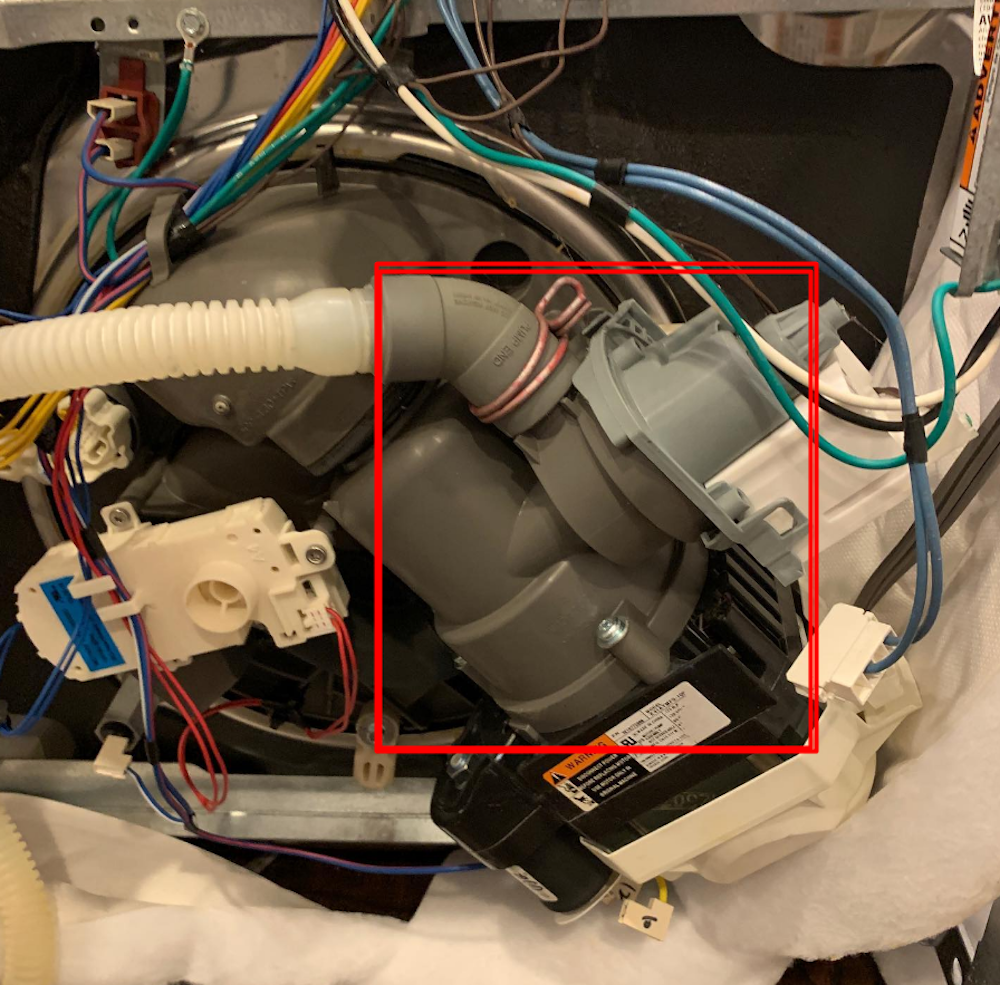
The first sign that the wash motor could be having a problem is if you cannot hear water spraying.
And if you open the door, the walls and dishes will all be dry.
Also:
Keep an ear out for any unusual noises, and an eye out for the wash motor error code (4-3).
To conduct a circulation pump motor test, follow these steps:
- Begin by turning off the water supply line and disconnecting the electrical power to the washer.
- Gently pull the washer out of its cabinet to access the backside.
- Carefully tilt the washer to gain access to the light blue power wires connected to the circulation pump motor and disconnect them.
- Once the wires are disconnected, return the washer to its upright position.
- Reconnect the water supply line and electrical power to the washer.
- Start a wash cycle and check for a voltage reading of 120V. If you are, the circulation motor is faulty.
According to Finn,
“The wash motor can also get jammed by a foreign object, so keep an eye out for that.”
If you find that the motor is working fine but the spray arms aren’t moving, the issue might be with the spray arms themselves.
Solution:
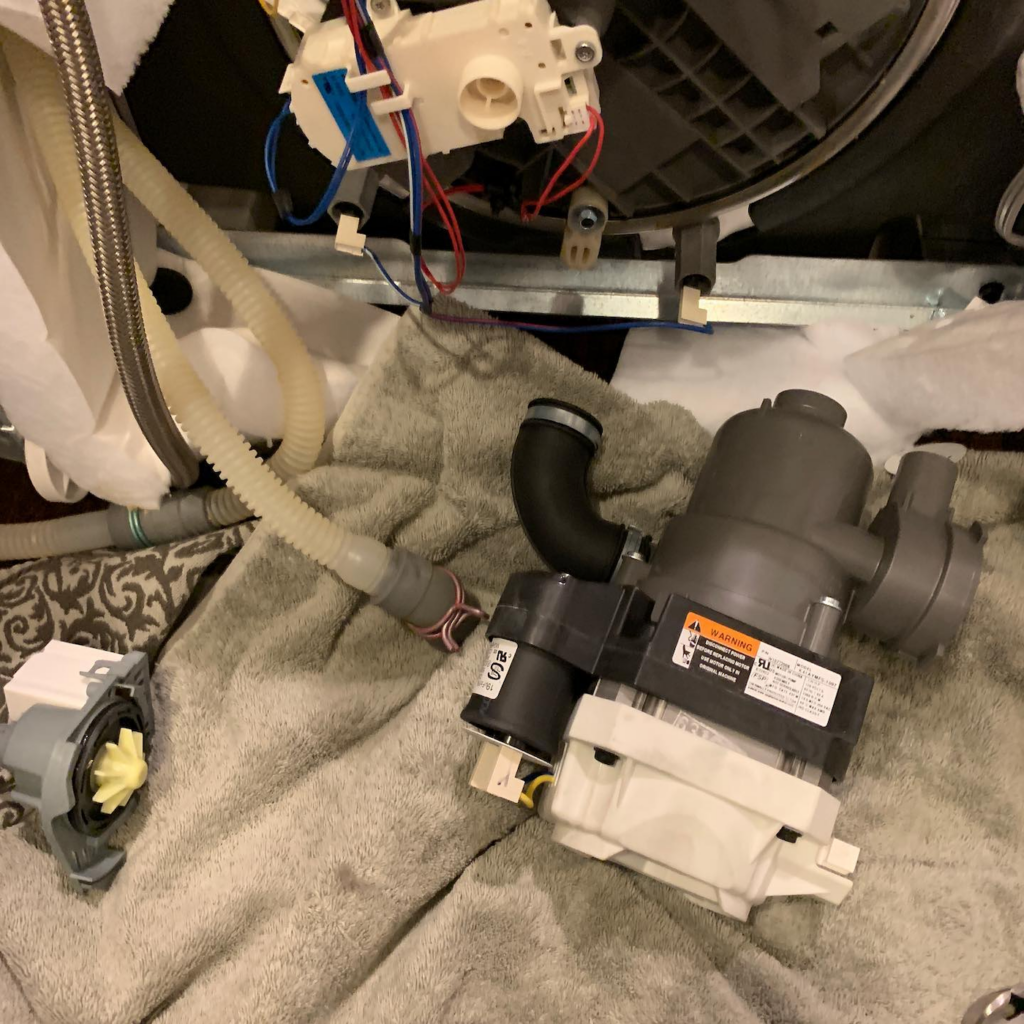
If the wash motor is jammed, simply remove the item causing the jam. And if there is a loose connection, secure it properly.
If the wash motor turns out to be faulty, replace it.
Check with your warranty to see if it’s covered. Some models come with a 1-year wash motor warranty, so you might be in luck.
9. Water Flow Problems
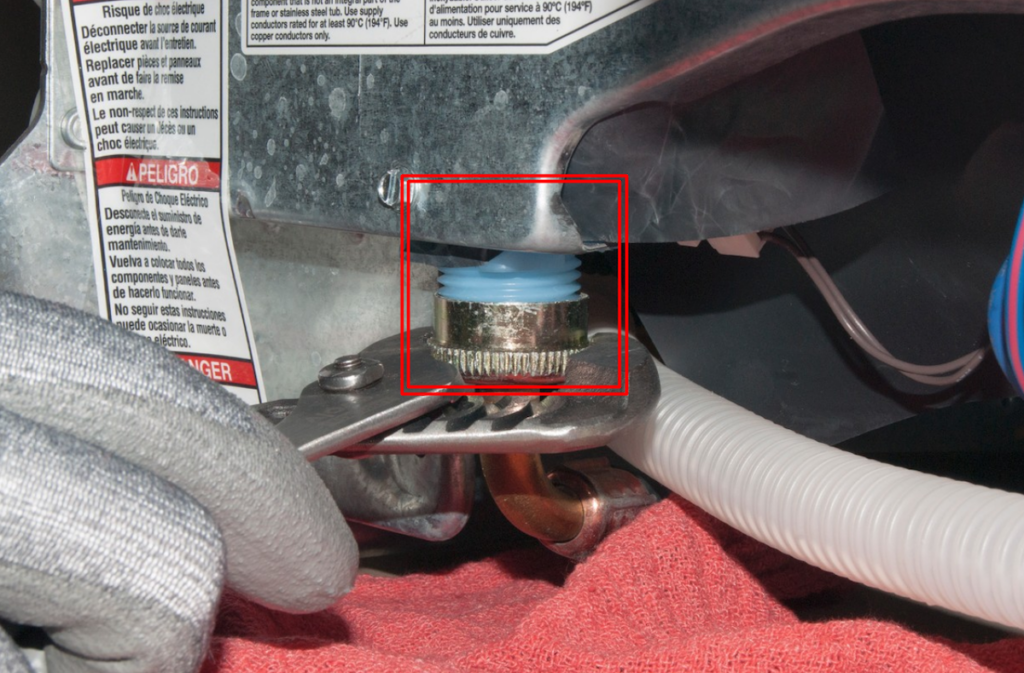
Another potential culprit behind a KitchenAid dishwasher beeping is water flow problems.
As Finn puts it,
“Just like a painter cannot paint without paint, a dishwasher cannot start without enough water.”
As Finn explains, there are several things that can cause water flow problems.
- Water supply valve is closed or partially closed.
- Faulty, stuck, or malfunctioning fill valve
- Low water pressure
- Clogged inlet screens
Now:
The process of water filling involves several key components, including the water inlet valve, control board, timer, and water level pressure switch.
“If any of these components is faulty or malfunctioning, it can lead to water filling issues,” Finn expounds.
Other components that would cause water flow problems include,
- Blocked spray arms
- Problems with the pump motor
- Float switch malfunction
- Timer or control board issues
- Faulty pressure switch
Identification:
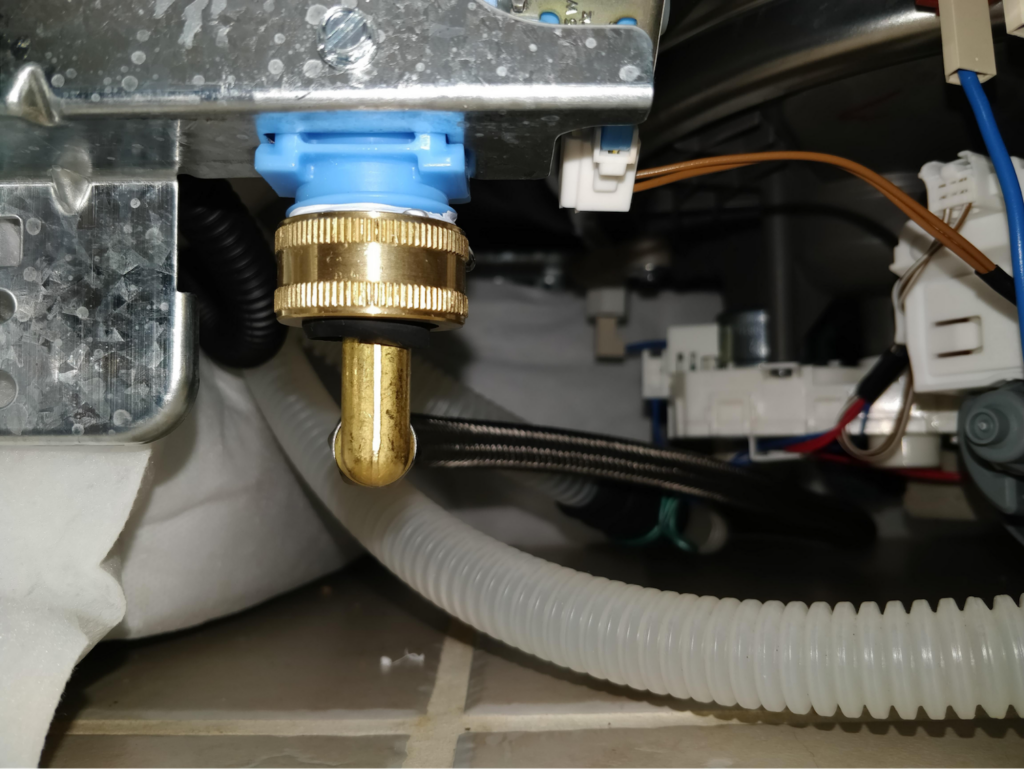
To troubleshoot water-filling issues, the trick is to start with the basics.
First things first:
Is water reaching your dishwasher? Ensure that the water supply valve, usually located under your kitchen sink, is fully open.
When here, locate the inlet screens and inspect if they are clogged.
If the water supply isn’t the problem, the next suspect is the water inlet valve. It’s located behind the kickplate at the bottom of your dishwasher.
Check if there is a blockage or signs of damage. Finally, test the valve’s solenoid.
Solution:
The fix here will depend on the specific issue you’re facing. This will range from simply cleaning the inlet valve screen to replacing a faulty component, such as the fill valve.
10. Other Culprits
Apart from the causes we’ve discussed above, there are other possible reasons why your KitchenAid dishwasher is beeping. This includes
- Control panel issues
- Blocked spray arms
- Clogged drain filter
- Setting-related (delayed start and locked control)
- No detergent or low rinse aid level
- Vent fan issues
- Damaged main pump filter
- When the dishwasher isn’t level
And by the way, did you know that you can change the sound level of your dishwasher?
Most Affected Models
From my experience, most KitchenAid dishwasher models tend to beep when they encounter certain issues.
Luckily, this guide applies to every model from this brand.
Here are a few of the models Finn and I have encountered with this issue. The list also includes some of the models that have been mentioned in our Facebook Group.
| Model Name | Model Number |
|---|---|
| KitchenAid Dishwasher in PrintShield™ Finish with FreeFlex™ Third Rack | KDTM404KPS |
| Kitchenaid Full Console Dishwasher | KDFE204KBL |
| KitchenAid Dishwasher Model | KDPM604KPS0 |
| KitchenAid Dishwasher | KDTE234GPS |
| KitchenAid Dishwasher | KDTE334DSS1 |
| KitchenAid 24″ Front Control Dishwasher | KDFM404KPS |
| KitchenAid Dishwasher | KUDE40FXSS3 |
| KitchenAid 24 Inch Fully Integrated Dishwasher | KDTM404KPS |
| KitchenAid Dishwasher | KUDC10IXWH4 |
| KitchenAid Top Control 24-in Built-In Dishwasher | KDTE254ESS |
| KitchenAid Dishwasher Model | KUDC10IXWH4 |
| KitchenAid – 24″ Built-In Dishwasher | KDPE234GPS |
| KitchenAid Dishwasher | KUDC10 |
| KitchenAid 24″ Front Control Dishwasher | KDFM404KPS |
| KitchenAid Dishwasher | KDTM404ESS3 |
| KitchenAid Top Control 24-in Built-In Dishwasher | KDPE334GPS0 |
| KitchenAid Dishwasher | KDFE204KPS |
| Kitchenaid 44 dBA Dishwasher | KDTM354ESS |
| KitchenAid Dishwasher | KDFE104DWH2 |
| KitchenAid Architect Series II Dishwasher | KDTM354DSS |
| KitchenAid Dishwasher | KDTE204EPA3 |
| KitchenAid Dishwasher | KDFE104DSS3 |
| KitchenAid Dishwasher | KDFE104HPS0 |
| KitchenAid Dishwasher | KDFE104DSS2 |
| KitchenAid Dishwasher | KUDS30FXSS9 |
| KitchenAid Dishwasher | KDPM604KPS0 |
Conclusion
Since KitchenAid dishwashers can’t talk, they cleverly use error codes, flashing lights, and beeping to communicate with you.
Luckily:
Beeping is very effective at getting the user’s attention. The tricky part is that beeping isn’t assigned to a specific problem.
That’s why many users have a hard time identifying the exact reason behind the beeping.
In this post, Finn and I have explored some of the major culprits behind a beeping KitchenAid dishwasher.
They include
- When an error is detected
- Opening the door during a cycle
- Using the wrong detergent, such as dish soap
- Software glitch
- Water flow issues
- Water in the drip tray or pan
- Other culprits include faulty components such as the wash motor, fill valve, door latch or
If you’re unable to identify the cause, reach out to KitchenAid support or a professional repair technician.
Finally:
Check out our Facebook Group, where you can connect with other users who might have encountered a similar problem.
Feel free to drop a comment below and let us know if you were able to fix your dishwasher.

